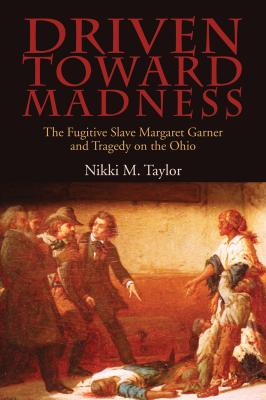Driven toward Madness. Nikki M. Taylor
Читать онлайн.| Название | Driven toward Madness |
|---|---|
| Автор произведения | Nikki M. Taylor |
| Жанр | Юриспруденция, право |
| Серия | New Approaches to Midwestern Studies |
| Издательство | Юриспруденция, право |
| Год выпуска | 0 |
| isbn | 9780821445860 |
DRIVEN TOWARD MADNESS
New Approaches to Midwestern Studies
SERIES EDITORS: PAUL FINKELMAN AND L. DIANE BARNES
Nikki M. Taylor, Driven toward Madness: The Fugitive Slave Margaret Garner and Tragedy on the Ohio
Jenny Bourne, In Essentials, Unity: An Economic History of the Grange Movement
DRIVEN TOWARD MADNESS
The Fugitive Slave Margaret Garner and Tragedy on the Ohio
Nikki M. Taylor
OHIO UNIVERSITY PRESS
ATHENS
Ohio University Press, Athens, Ohio 45701
© 2016 by Ohio University Press
All rights reserved
To obtain permission to quote, reprint, or otherwise reproduce or distribute material from Ohio University Press publications, please contact our rights and permissions department at (740) 593-1154 or (740) 593-4536 (fax).
Printed in the United States of America
Ohio University Press books are printed on acid-free paper
Cover credit: Thomas Satterwhite Noble, The Modern Medea (1867).
From the Collection of the National Underground Railroad Freedom Center.
27 26 25 24 23 22 21 20 19 18 17 16 5 4 3 2 1
Library of Congress Cataloging-in-Publication Data
Names: Taylor, Nikki Marie, 1972– author.
Title: Driven toward madness : the fugitive slave Margaret Garner and tragedy on the Ohio / Nikki M. Taylor.
Description: Athens : Ohio University Press, 2016. | Series: New approaches to midwestern studies | Includes bibliographical references and index.
Identifiers: LCCN 2016041893| ISBN 9780821421598 (hc : alk. paper) | ISBN 9780821421604 (pb : alk. paper) | ISBN 9780821445860 (pdf)
Subjects: LCSH: Garner, Margaret, 1834–1858. | Fugitive slaves—Kentucky—Biography. | Fugitive slaves—Legal status, laws, etc.—United States. | Fugitive slaves—Legal status, laws, etc.—Ohio—Cincinnati. | Garner, Margaret, 1834–1858—Trials, litigation, etc. | Infanticide—Ohio—Cincinnati—Case studies.
Classification: LCC E450.G225 T39 2016 | DDC 306.3/62092 [B]—dc23
LC record available at https://lccn.loc.gov/2016041893
For Black Women and Their Unconquerable Spirits, Past and Present
CONTENTS
Introduction: Bodies and Souls
4. “Faded Faces” Tell Secrets—or Do They?
5. Driven by Madness, Badness, or Sadness?
ILLUSTRATIONS
FIGURES
1.1. Pencil drawing of the Thomas Satterwhite Noble painting The Modern Medea
3.1. Lucy Stone, November 1853. Photograph by G. W. Bartlett
PLATES
1. Anti-slavery Bugle, 2 February 1856
2. Murder indictment for the Garners, 8 February 1856
3a–c. Narrative of the Ohio murder indictment against the Garners, 15 May 1856
4. Order given to the sheriff to deliver the Garners to the federal marshal, 28 February 1856
5a–d. Letter from county prosecutor Joseph Cox to Governor Salmon Portland Chase, outlining the state and federal custody battle over the Garners, 29 February 1856
6. Letter from county prosecutor Joseph Cox to Governor Salmon Portland Chase, 15 May 1856
SERIES EDITORS’ PREFACE
For much of American history the term “Midwest” evoked images of endless fields of grain, flat, treeless landscapes, and homogenized populations in small towns. Most Americans hear “Midwest” and think of corn, wheat, soybeans, massive feedlots, huge pig farms, and countless dairy herds. The cinematic Midwest was River City, Iowa, in The Music Man; Dorothy trying to escape Oz and get back to Kansas; the iconic power of small-town basketball portrayed in Hoosiers; or a mythical baseball diamond in rural Iowa in Field of Dreams. In the late twentieth century, images of deindustrialization and decay linked the region to a new identity as the nation’s Rust Belt. For too many Americans, the Midwest has been “flyover country.”
This book series explores regional identity in the nation’s past through the lens of the American Midwest. Stereotypical images of the region ignore the complexity and vibrancy of the region, as well as the vital role it has played—and continues to play—in the nation’s economy, politics, and social history. In the antebellum and Civil War periods the Midwest was home to virulent racist opponents of black rights and black migration but also to a vibrant antislavery movement, the vigorous and often successful Underground Railroad, and the political and military leadership that brought an end to slavery and reframed the Constitution to provide at least formal racial equality. A midwestern president issued the Emancipation Proclamation, and midwestern generals led the armies that defeated the southern slaveocracy. Midwestern politicians authored the Thirteenth Amendment ending slavery and the Fourteenth Amendment mandating legal equality for all Americans. The political impact of the region is exemplified by the fact that from 1860 to 1932 only two elected presidents (Grover Cleveland and Woodrow Wilson) were not from the Midwest. Significantly, from 1864
